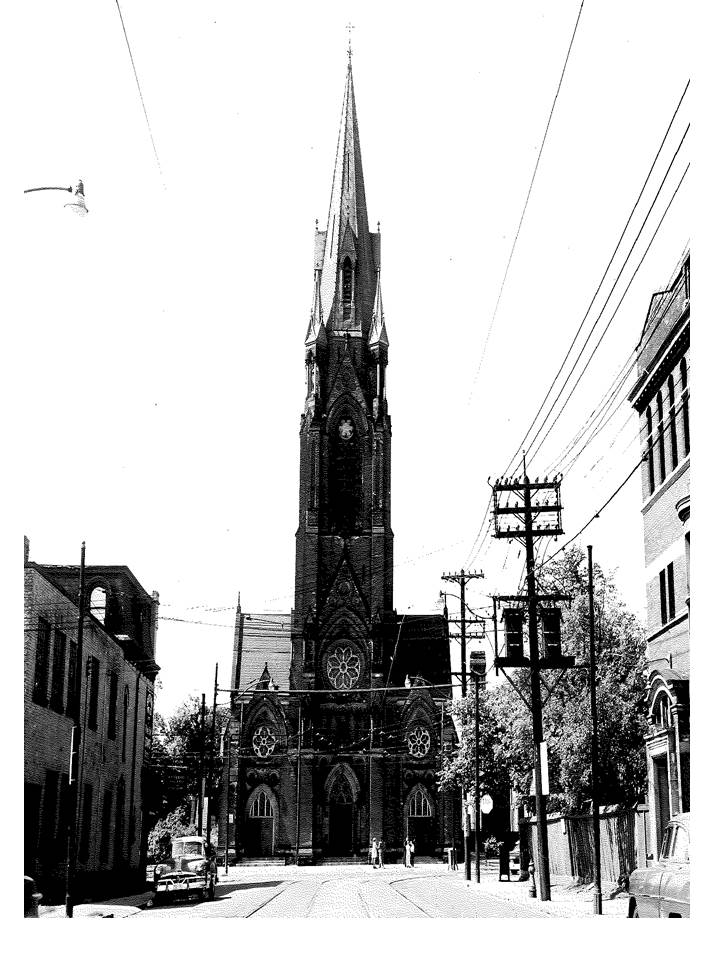
The History of St. Mary's
History of St. Mary's
The history of St. Mary's church predates the actual building and begins in 1835 when the forward thinking first bishop of Upper-Canada , Alexander Macdonell foreseeing the growth of the catholic population westward petitions the Lieutenant governor Sir Francis Bond Head , for a grant of a piece of land on the Garrison reserve. The petition promised that if land were granted on the reserve a church would be built offering free seats for the military. Bishop Macdonell was granted the lot subject to the condition that the church be built immediately. This however proved to be impossible due in part to the lack of sufficient funds and a congregation large enough to provide them. The land that was granted to Bishop Macdonell on the north east corner of the garrison reserve was given in part due to it having served as an emergency cholera cemetery during the great epidemics that hit York (Toronto) in 1832 and 1834. A fact that would only come to light as the church foundations were being dug and the vast number of human remains in unmarked graves were discovered.
The job of building the first St Mary's fell to Bishop Armand Francois Marie de Charbonnel who through his many contacts overseas managed to acquire sufficient funds to build a "small church built of white brick 100 feet long and 42 feet wide". Bishop Charbonnel much like his predecessor had found the cost of building the small church and seminary as well as undertaking the building of the cathedral too much to bear and so he was unable to finish the wooden seminary. This proved to be a great disappointment to the newly arrived Basilian fathers who were forced to open their little seminary in a rented house on Queen and Church Street.
The parish was then served by Father John O'Neill the second pastor who was responsible for building a rectory next to the church. But it was in 1856 that St. Mary's received its third and most prominent pastor, Fr. Louis de Lavagna a Capuchin Franciscan that had gained a saintly reputation for his ascetic lifestyle and his ability to restore the capuchin order in both France and England. His time as pastor of St Mary's was not long as he died of pneumonia shortly after his first Canadian winter. His body was taken to the cathedral were it lay in state for two days because the first St. Mary's church was falling apart due to foundation issues . In 1858 there was a contract for the "taking down, remodeling and rebuilding" of the first St Mary's church, this led to the creation of a second church unwisely built on the foundations of the first. This second St. Mary's was consecrated by Bishop Lynch on May 6th ,1860.
As time went on the second church also started to experience structural problems and although iron girders were installed, the decision was finally made to build the third (current) church. Under the direction of Fr. Francis Patrick Rooney and with the influence of the bishop of London John Walsh (former pastor of St Mary's), prominent architect Joseph Connolly was chosen to design the new building. Connolly set about designing a church in the French Gothic revival style, popular at the time, which was 160 feet long by 74 feet in the transepts made of white brick and Ohio sandstone with granite pillars and a vaulted roof of white pine. The corner stone was laid on the feast of the Assumption in 1885 and work commenced lasting four years and costing $70 000. The church was officially opened to the congregation on February 17, 1889 and was richly decorated with frescoes depicting various religious images in 1892. Once again, due to lack of funds the church spire was only completed in 1905 by Connolly's protégé, architect Arthur W. Holmes.
Throughout its long history St. Mary's has always served as a home to the poor immigrant communities who have left their marks. First it served as a home to the Irish immigrants escaping from the potato famine, then came the Ukrainians and Polish and those were followed by the Portuguese who started to arrive in the 1960's. It was at this time that some of the current traditions of St Mary's were started. With the arrival of the Ecce Homo statue in 1965, an image highly revered by the Portuguese of Azorean decent the need arose to create a brass band for the procession the following year.
Currently St. Mary's parish is undergoing a renaissance, both in the church structure and in the parish itself. The congregation continues to change and adapt to the diverse neighbourhood it serves, including urban professionals that are rapidly moving into the downtown core. What the future holds for St. Mary's only God knows, but whatever it is it will only add to the rich history it has acquired thus far.
